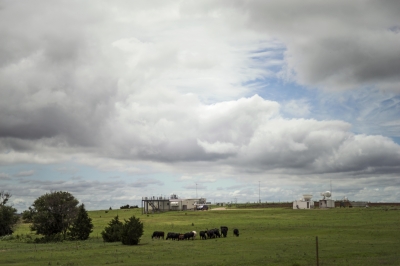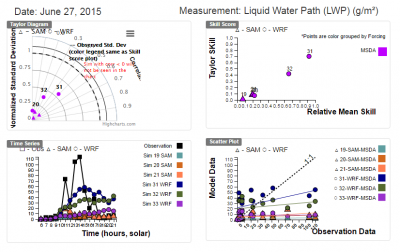LASSO Released First Results, Corralling Models and Measurements
Published: 15 August 2016
The Alpha 1 release of LASSO showcases features and solicits feedback

LASSO has been roping measurements and wrangling models for a year, and the project just released its first set of results, Alpha 1.
LASSO: An Integral Part of ARM’s Future
LASSO, or Large-Eddy Simulation (LES) ARM Symbiotic Simulation and Observation workflow, is a two-year pilot project meant to bring measurements and models closer together by pairing ARM observations with LES output. Instead of researchers getting the measurements from ARM and then undergoing the laborious process of running their own models, atmospheric scientists can now access simulations that are pre-matched to the observational data sets, which provides a handy starting point for their own research.
The matched measurements and models are released together in a comprehensive product called “data bundles.” Each data bundle has everything needed to reproduce and examine the simulations, including model inputs and outputs, ARM observations matched to the model grid, model diagnostics and skill scores, and quicklooks of various fields.
Making Data Accessible

This initial Alpha 1 release only covers five days from 2015, but includes 192 simulations and takes up three terabytes of data. Users can access the data through the LASSO Bundle Browser, a convenient method for researchers to only select the data they find relevant.
Bill Gustafson, principal investigator of LASSO and climate scientist at Pacific Northwest National Laboratory, describes the Bundle Browser as an integral part of the LASSO project.
“The Bundle Browser is a web app, developed by Bhargavi Krishna at Oak Ridge National Laboratory, that helps users filter and sort the data. It really lets users focus down on what they need, instead of having to sort through everything.”
Information for Any Kind of Atmospheric Researcher
Gustafson and the LASSO team focused on three user groups in particular: Observationalists, theoreticians, and modelers. For example:
- An observationalist could test retrieval algorithms and measurement strategies.
- A theoretician could examine the assumptions used in model parameterizations.
- A modeler could use the vetted simulations as a starting point for their own simulations tailored to their specific needs.
“We wanted to make the information as transparent as possible so it’s useful to a broad range of users,” said Andy Vogelmann, co-principal investigator and atmospheric scientist at Brookhaven National Laboratory. “We’re even planning on releasing the source code as well at the end of the project.”
Finalizing LASSO, a Step Toward ARM Goals
LASSO is just a pilot project, a two-year test of the new approach. It works toward fulfilling ARM’s reconfiguration outlined in the Decadal Vision to establish observation-modeling megasites, with a focus on bringing LES capabilities to the Southern Great Plains (SGP) site. To provide needed additional observations, ARM recently reconfigured its instrument deployment to expand the SGP’s repertoire.

Gustafson and Vogelmann are soliciting user feedback before they finalize the initial content and procedure for building the data bundles, which will go operational by the end of next spring. They released the Alpha 1 data set halfway through the pilot to give users a chance to see what’s available and to offer any advice that would improve the product.
The initial focus of LASSO is on shallow clouds at the SGP. If all goes well, the ARM Facility could expand the data bundle offerings to include new sites or new modeling scenarios, such as deep convective clouds.
Vogelmann predicts that LASSO will run 20-30 cases a year, depending on meteorological conditions, and Gustafson envisions a “library of cases with a large range of variability, ultimately numbering in the hundreds.”
Making a Difference for Climate Modeling
The LASSO project is already breaking new ground and providing valuable data. “In the past, LES simulations would be run for a very specific case, often idealized,” Vogelmann explained. “This is a change in course, if you will. We’re making a statistical library available that is very important for improving climate model parameterizations and simulations.”
The Alpha 1 release is now available to view. Provide feedback by contacting either Bill Gustafson or Andy Vogelmann, or sign up to receive updates by joining the LASSO information email list.
# # #
The ARM Climate Research Facility is a national scientific user facility funded through the U.S. Department of Energy’s Office of Science. The ARM Facility is operated by nine Department of Energy national laboratories, including the Pacific Northwest National Laboratory, Brookhaven National Laboraotry, and Oak Ridge National Laboratory.
The ARM Climate Research Facility is a DOE Office of Science user facility. The ARM Facility is operated by nine DOE national laboratories, including .
Keep up with the Atmospheric Observer
Updates on ARM news, events, and opportunities delivered to your inbox
ARM User Profile
ARM welcomes users from all institutions and nations. A free ARM user account is needed to access ARM data.


















